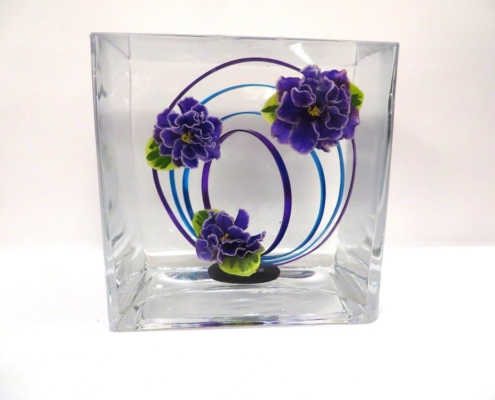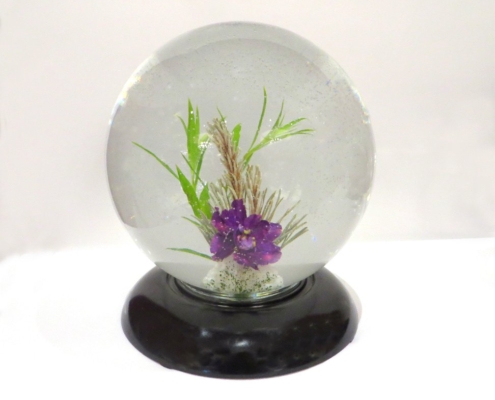 Underwater Flower Arrangements
Underwater Flower Arrangements
Written by Edna Rourke
Published in the African Violet Magazine May/June 2012.
Updated 2020
Introduction
An Underwater Flower Arrangement is an arrangement that is completely submerged in water and exhibited in a transparent container. As in any other interpretive arrangement, the purpose of these designs is to display African violet blossoms in a pleasing and artistic manner.
The African violet blossom should be the focus or center of interest in the design. The blossoms are enhanced, supported and accentuated using interesting line and plant material. All plant material should be cut and in good condition.
In an Interpretive Design class, interpretation of the title of the class is the goal. This interpretation can be either “suggestive” or “obvious.” It doesn’t mean that the interpretation must be literal. The choice is yours. I personally feel “suggestive” to be the better of the two choices.
In order to do an underwater flower arrangement, the same elements and principles of design must be followed. The AVSA Handbook for Growers, Exhibitors and Judges is an excellent reference and a tremendous source of information. All these elements and principles are listed and fully explained. Once you study and understand these elements and principles, your designs will be accomplished easily.
Plan and Assemble Your Materials
Select the container
A container should be of clear glass and free of any designs or etching – a design or pattern in the glass will be distracting and take away from the design. Some examples of suitable containers are brandy snifters, pitchers, bowls, jars, fish tanks, and bubble bowls.
Select plant material
Please keep in mind that everything you place in the container will be magnified. Note when water is added, depending upon the shape and thickness of the glass of the container you use, everything you put in the container will be magnified. A round bowl will magnify more than either a vertical or straight-sided container.
When selecting your plant material, make sure it is clean. Be selective with all the components. Wash all plant material and prune any damaged foliage or other imperfections. Again, keep in mind that everything will be magnified and visible.
When selecting the blossoms, choose varieties that have substance, rather than the very delicate ones. They are more likely to hold up better and will not deteriorate as easily. Choose freshly opened blossoms as well as buds.
Details
If possible, do your arrangements in advance so you have the time to try it in your container with water and make any adjustments necessary.
If you plan on using a bubble bowl, remember your design will have to be inverted. You will have to make sure that all your materials are anchored securely.
Mechanics
The same mechanics you would use in a standard design to hold everything together may be used in an underwater arrangement. However, in an underwater arrangement, material is used to conceal the mechanics.
You can use pin holders, floral clay, or straws wrapped with floral tape to hold the stems of blossoms or plant material. Any of these may be anchored with design clay or cling. Fine floral wire or fish line may be used to hold fine line material and foliage together before anchoring to a base. Fine gravel or stones, shells, clear marbles, or glass chips are some examples of materials you can use to cover a pin holder. Remember, before using any of these items, wash then thoroughly to remove any dirt.
A glue gun also works quite well to anchor an underwater arrangement to the container as well as to the individual parts. The plant material can absorb water through the stems and leaves and the blossom stays fresh.
Line Material
There are many kinds of materials that can be used, and the following are just some examples: various types of willow branches, bittersweet vine, wisteria vine, grape vine, spiraea, forsythia, ivy, barberry, Harry Lauder Walking Stick, cotoneaster, Chinese holly, etc.
Foliage
Again, there are many plants available to use. Examples are boxwood, holly, ivy, African violet leaves, columnea, nematanthus, ajuga, pachysandra, etc. to name but a few.
Creating Your Design
- Have your container, mechanics, and plant material ready.
- Establish and anchor your line.
- Keep it uncluttered and clear.
If using a bubble bowl, anchor the pin holder to the bottom of the cover and work accordingly. Invert into water. If you are using another type of container, insert your design into a dry container when it is completed and anchor well. Add water carefully a little at a time by pouring onto the sides of the container and not onto the design itself.
Reminders worth repeating
- Keep your design simple.
- Emphasize the line.
- Keep it uncluttered.
- Size and color are very important.
- Do not have any part of your materials above the water level.
- Try not to bruise blossoms.
- Make sure plant material does not touch the sides or top of the container.
Dos and don’ts of what water to use
- Do not use chemically treated water.
- Do not use heavily chlorinated water.
- Do not use warm water.
You can draw your water a couple of days in advance and let it stand. I use inexpensive spring water sold in any grocery store. For me it has become a quicker and more convenient alternative.
Air bubbles in your container are not penalized. Sometimes they even enhance the design.
As you know, for all of us these days, time is at a premium. But, if you take the opportunity to practice before show time, you will find out how much easier it becomes to design an underwater arrangement.




